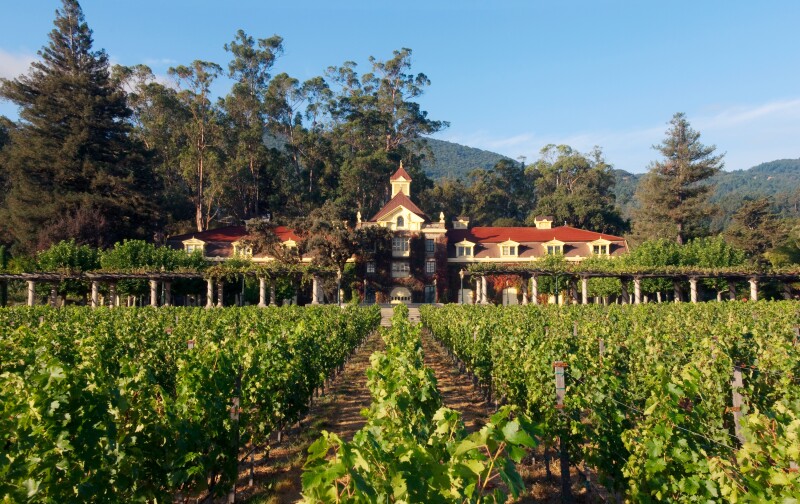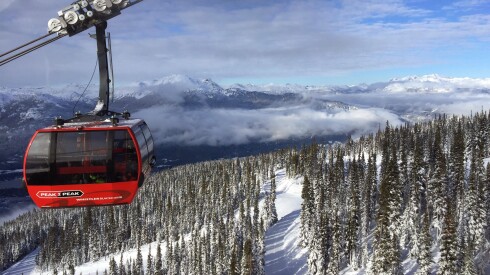France—the home of Burgundy Grand Crus, Bordeaux first growths, and UNESCO-designated champagne caves—is the oenophilic holy grail. But excellent wine is being made all over the world nowadays, from Australia’s southern coast to Canada’s Okanagan Valley.
In the United States, many domestic regions offer hillside-vineyard scenery that rivals the French countryside, hospitable tasting rooms, as well as outstanding wines from French regions, including a California varietal that beat Bordeaux in at least one legendary blind tasting. Fall is a lovely time to visit the vineyards, when summer crowds thin, harvest festivals commence, and grapevines turn their autumnal hues. Here are five ways to get a facsimile of a famous French wine style here on domestic soil this fall.
See why Napa Valley beat Bordeaux

Inglenook in Napa Valley uses French Bordeaux for inspiration.
Courtesy of Inglenook
Napa Valley put American winemaking on the map in 1976, when two local wines, a cabernet sauvignon from Stag’s Leap Wine Cellars and a chardonnay from Chateau Montelena, beat the best reds from Bordeaux and the best whites from Burgundy in a blind tasting with 12 French judges. Today, five of the six U.S. wineries that were top competitors in what is now commonly called the “Judgment of Paris” are in the Napa Valley and still make cabs that compare to first-growth Bordeauxs.
The French have since moved in. In 1978, Baron Philippe Rothschild of Château Mouton-Rothschild partnered with Robert Mondavi to found Opus One. Many have followed suit, including Philippe Bascaules, who is both the managing director at Chateâux Margaux in Bordeaux and the director of winemaking at Francis Ford Coppola’s Napa Valley winery, Inglenook. “When I joined Inglenook in 2011, we made an intentional shift in the style of our wines,” Bascaules says, noting that many present-day Napa cabs run toward higher alcohol and tannin. “Inglenook became one of the first wineries to return to Bordeaux for inspiration.”
Will you prefer a more French expression, like the ones at Inglenook and Opus One, or a more high-powered American take? There’s only one way to find out.
The weather in Northern California is best in the early fall, which happens to coincide with harvest time. That means the whole valley will be abuzz with harvest festivals and activities like grape-stomping.
Where to stay: This wine country is booming with five-star resorts, but the most Gallic experience is at Auberge du Soleil, which is dotted with olive trees and designed to look like a modern Provencal estate. French restaurateur Claude Rouas cofounded the property in the 1980s, and its signature restaurant has held a Michelin star for 17 years.
Follow the Burgundians to Oregon’s Willamette Valley

The Willamette Valley wine region abuts green forests in Oregon.
Photo by Jim Ekstrand/Shutterstock
Napa isn’t the only place with a terroir that attracted high-level French winemakers. Oregon’s Willamette Valley produces such complex pinot noir and chardonnay varieties that vintners from Burgundy—perhaps the most hallowed of all French regions, and one that is defined by those two grapes—have set up shop here. It started in 1987 when Robert Drouhin and his daughter, Véronique, of Maison Joseph Drouhin, began Domaine Drouhin Oregon. Later came winemakers from Maison Louis Jadot, who founded Résonance, and even the legendary Domaine de la Romanée-Conti, with Bertrand de Villaine starting an Oregon project called Composition.
“Oregon is like Burgundy in that it is difficult to understand,” says Jean-Nicolas Méo, a cofounder of Nicolas-Jay Estate, who also makes grand crus from some of the best sites in Burgundy at Domaine Méo-Camuzet. “There is so much diversity and variability in the wines. Oregon is a region of relatively small wineries, led by people who are able to express themselves with pinot noir, which is very similar to what we have in Burgundy.”
Guillaume Large, a Burgundy native who has been the winemaker at Résonance since 2016, also sees similarities. “Both places,” he says, “share a love of the good life: great wine, delicious food, and a deep respect for the land.”
The Willamette Valley is rainy during winter and spring, but come summer and the first half of fall, the clouds give way to gloriously sunny yet mostly mild days—perfect for an outdoor tasting. The drizzle typically returns around the end of October, although there’s still something charming about a cloudy, moody day in the Pacific Northwest.
Where to stay: For a back-to-the-land, pastoral experience worthy of the French countryside, stay at Inn the Ground, a hillside boutique property with panoramic valley views. The owners also own a farm, Tabula Rasa, where they practice regenerative agriculture.
Experience an Alsatian blend of France and Germany in New York’s Finger Lakes

The owners of Apollo’s Praise honeymooned in Alsace, France, where winemakers produce the same wine varietal as in the Finger Lakes.
Courtesy of Apollo’s Praise
Alsace is a culturally unique region of France, thanks to the influence of Germany across the Rhine River. It’s also unique viticulturally, as its colder climate leads winemakers to focus on grapes such as riesling and gewürztraminer. The similar climate and the similarly various terroirs in the Finger Lakes of western New York lend themselves to the production of some of the best Alsatian-style wines in the USA.
“Alsace and the Finger Lakes have remarkably diverse soils that can change within a single vineyard row, and that pushes both of our regions toward single-vineyard and very distinct expressions,” says Kelby James Russell, co-owner and winemaker of Apollo’s Praise in Rock Stream, New York. “What the Finger Lakes can do that is distinct, however, is make rieslings of all styles. Alsatian riesling is either bone-dry or dessert-sweet, and the Finger Lakes embraces the full rainbow of expressions that are possible with this wonderful grape.”
Russell, who took his honeymoon in Alsace after eloping with Apollo’s Praise co-owner, Julia Rose Hoyle, also offers a culinary recommendation: “[Phelps, New York,] still calls itself the sauerkraut capital of the world. While that may be a bit of a dubious claim, the Finger Lakes, much like Alsace, adores sauerkraut. The quintessential Alsatian preparation, choucroute garnie, served with tons of sausages, ham knuckle, and potatoes cooked right in the sauerkraut, is the perfect pairing for dry riesling.”
Visit Upstate New York in early fall, and you’ll be able to sip your wines while gazing at lakeside trees in their annual deciduous color display.
Where to stay: It’s not French, per se, but the historic Argos Inn, in the charming downtown of Ithaca, has some European flair with its displays of original Salvador Dalí and Joan Miró paintings.
Get stoned, Rhône Valley–style, in Walla Walla

The stony soil in Walla Walla, Washington, produces similar wine to France’s Rhône Valley.
Photo by Danita Delimont/Shutterstock
Southern France’s Rhône Valley is a diverse wine region that stretches from south of Lyon to within spitting distance (or spit-bucket distance) of the Mediterranean Sea. Perhaps the best-known subregion in the valley is Châteauneuf-du-Pape, so-called because the pope moved his residency here for a period during the 14th century. From a wine perspective, Châteauneuf-du-Pape is famous for powerful blends based mostly on grenache, syrah, and mourvèdre. These wines draw their distinctive character in part from soil that’s composed of rocks called galets roulés (rolled pebbles).
The pope may never have lived in Walla Walla, Washington, but the region does resemble Châteauneuf-du-Pape in some ways. Within the Walla Walla Valley American Vinticulture Area (AVA), across the Columbia River in northeastern Oregon, is a small subregion called the Rocks District of Milton-Freewater. The soil here is characterized by cobblestones deposited by the Walla Walla River, and the terroir, as one would guess, produces great Rhône-style grenache, syrah, and mourvèdre.
“When I tripped on the Rocks District, there were only 35, 40 acres of wine grapes in that area,” says Delmas Wines owner Steve Robertson, who helped drive the establishment of the subregion as an AVA in 2015. “Basically, it was orchards. Through the orchard rows, I could see tons of these river rocks, and I went, ‘Oh, I need to find out what this is all about.’”
By that time, a French transplant named Christophe Baron who had made the same discovery was already making highly sought-after Rhône-style wines at Cayuse Vineyards, and the 10 years since the AVA was established have seen the rise of other acclaimed vineyards, including Pášxa and Cimento. “You’re going to have kind of these round, opulent mouthfeel flavors,” Robertson says of the local wines. “There’s really no harsh edges.”
In eastern Washington and Oregon, winters can be frigid and summers are scorching, but fall is lovely, with an average October high of 73 degrees. Be sure to bring a jacket, though, as the high-desert climate means temperatures can drop precipitously once the sun goes down.
Where to stay: For old-school accommodations worthy of a pontiff, stay in downtown Walla Walla at the Marcus Whitman, “the Grand Dame of the Palouse,” a 1928 hotel that’s listed on the National Register of Historic Places.
Pop Champagne-approved bottles in rustic Anderson Valley

The Roederer Estate produces sparkling wine comparable to champagne.
Photo by Dawn Heumann
Northern California’s Anderson Valley wouldn’t seem to have much in common with Champagne. Instead of a 45-minute fast train from Paris, road-trippers drive two-and-a-half hours (the last 45 minutes on a winding canyon road) from San Francisco. And rather than a 700-year-old cathedral in Reims, visitors admire the old-growth redwood trees in Hendy Woods State Park. Climatically, though, both are perfect for growing pinot noir and chardonnay, the main varieties used in the Champagne region of France. Just ask the company Louis Roederer, the French maison best known for making Cristal, which founded Roederer Estate here in 1982.
“We didn’t have a tasting room there until the ’90s. But the wines proved to be of a beautiful caliber,” says Nicole Carter, Roederer Collection’s president of U.S. wineries. “Fast-forward to today, and we own and farm 25 percent of the Anderson Valley appellation.”
While the area’s remoteness still keeps traffic relatively low, Louis Roederer is investing in infrastructure, debuting a major redesign of the tasting room earlier this year. The rest of the valley is dotted with excellent wineries such as Goldeneye and Navarro (many of which produce excellent still wines in addition to sparkling), as well as gems including Disco Ranch, a wine bar and bottle shop that won Wine Spectator’s Award of Excellence in 2024 for an encyclopedic global list that includes, yes, a lot of French champagne.
While the weather is cooler up here than in Napa, fall remains an excellent time to visit, with relatively little rain and the vineyards turning autumnal red and gold. As a bonus, if you’re here in November, you can make the drive over to the Mendocino coast to watch for migrating gray whales.
Where to stay: Looking for a French connection? The 17-room Boonville Hotel, an upscale roadhouse with a modern barn–style public space, is owned by the Schmitt family, who ran the French Laundry in Napa Valley before selling the restaurant to Thomas Keller in 1994. Friday through Monday, the hotel’s restaurant serves an excellent five-course dinner, featuring dishes ranging from Mount Lassen trout to paella.











